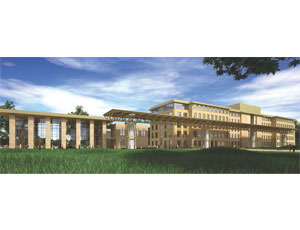...engineer with the manufacturer’s representative Oregon Air Reps of Lake Oswego, Ore. “You move the air more efficiently, and you are not creating noise.”

At Maxim, the original air from the handlers hit the wall of the duct, introducing vibration into the building.
“With the FANWALL, it’s more uniform and has eliminated a lot of vibrations,” Patel says.
Colligan adds that the array provides active and passive noise reduction and internal sound isolation. The insulation the manufacture includes provides the active noise reduction, and the adjacent fans create a passive countereffect, masking the sound.
In addition, the FANWALL eliminates some ongoing maintenance. The old equipment had belts, bearings and other components that needed quarterly service and were a potential point of failure, which could take down operations for weeks.
“With FANWALL, we have multiple cells in an array to deliver the same amount of air,” Colligan says. “There are no belts, and the only bearings are internal to the motors. If you were to lose a cell, it will not shut down operations. The other cells will pick up the slack. They are on a variable-frequency drive.”
Colligan says it is difficult to put a dollar figure on the savings associated with not shutting down a clean room and the potential loss of product, “but we know it is substantial, and using FANWALL eliminates that concern.”
The FANWALL installation is a part of Maxim’s ongoing energy-saving program, Patel says. It began about two years ago when it upgraded its 1,200-ton chiller to a variable-frequency unit. That conversion saves 1.2 million kilowatts annually. Then last year, the company installed a variable-speed, compressed-air system, which saves 1 million kilowatts per year, and a blower bulge driver that saves 290,000 kilowatts annually.
“Everyone should look into these types of projects, because there is always room to save,” Patel says. “Take advantage of the incentive programs that are out there.”
Oregon Program Spurs Retrofits
The nonprofit Energy Trust of Oregon offers financial incentives to businesses seeking to save energy. Lawmakers created the trust in 1999, requiring the state’s two largest investor-owned utilities to collect a 3% public-purpose charge from their customers. Later, two gas companies joined the trust.
Energy Trust uses those dollars to fund its programs. In 2008, the trust received about $64 million from PGE, Pacific Power, NW Natural and Cascade Natural Gas. As of October, Washington customers of NW Natural can avail themselves of some Energy Trust services, resources and incentives.
Since 2002 when the trust began operations, Oregon households and businesses have saved $440 million by making energy-efficiency improvements and helped the state avoid emitting 3 million tons of carbon dioxide emissions.
“The Energy Trust has had a big impact on driving [energy retrofits] forward,” says Bret Dawson, a control department manager with Hunter Davisson of Portland. “When money is made available to help subsidize work of this type, smart people are jumping on the bandwagon. Over the last four years, I’ve seen an increase in the people approaching building enhancements with fervor.”
Contractors can become a Trade Ally with the trust, which allows them to study and develop energy-saving plans. The Energy Trust evaluates the study and will offer incentives if the project meets its criteria.
In addition, the Oregon Department of Energy offers Business Energy Tax Credits.
“We’ve had projects covered up to 50% to 60% with both the tax incentive and Energy Trust incentive,” Dawson says. “It’s based on the amount of payback perceived by the measures proposed.”
Incentives Plus Interest in Green
Incentive programs and a general interest in conservation and reducing energy costs are generating owner retrofits.
“There’s a general push to LEED and competition, with so many buildings going green,” says John Bates, director of energy services for Holaday Parks of Seattle, a mechanical systems design, fabricaion, installation and service firm. “No one wants to have a building that isn’t at least somewhat green.”
Bates adds that tenants are requesting LEED energy-efficiency features.
In addition, utilities are a driver, with Seattle City Light and Puget Sound Energy offering rebates, Bates says. Seattle City Light’s Web site reports that it offers energy-savings incentives as high as 70% of the installation cost.
The federal government is promoting energy efficiency. The Seattle Housing Authority received $10 million in America Recovery and Reinvestment Act of 2009 funding to rehabilitate Denny Terrace, a 221-unit, public-housing, high-rise tower in Seattle. The project goal is to increase energy conservation to the highest level possible with installation of an insulated finish system, new energy-efficient windows and replacement of the old hot water heating system.




Post a comment to this article
Report Abusive Comment